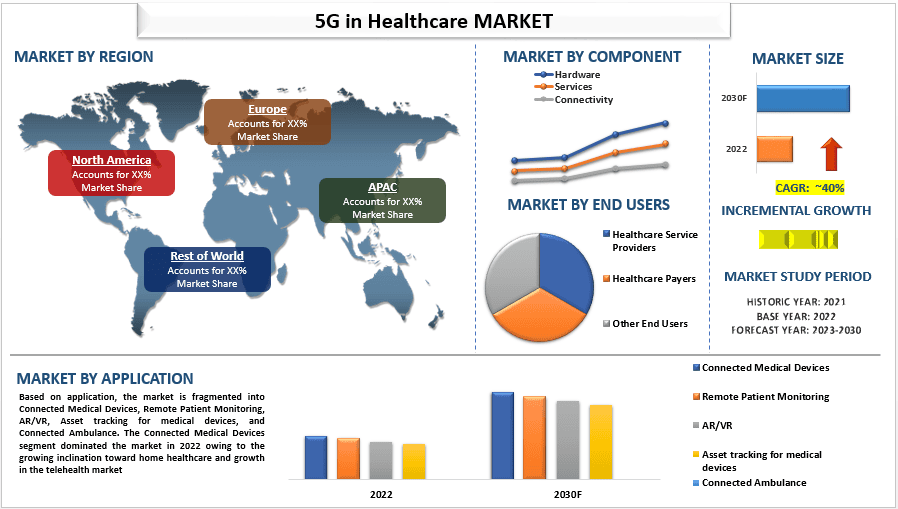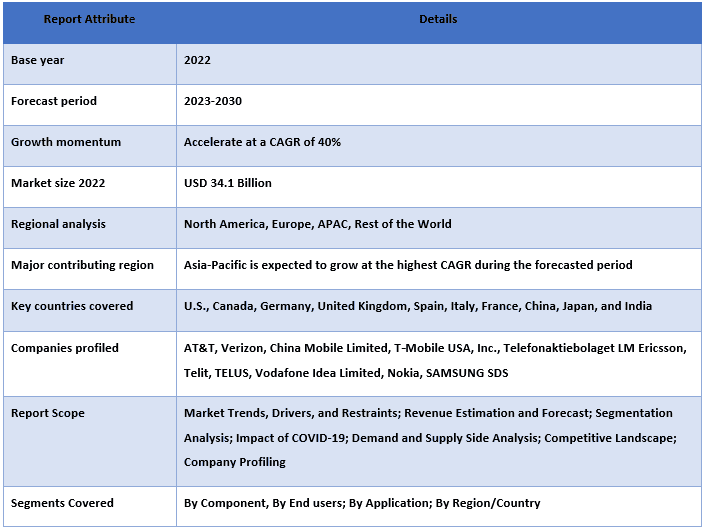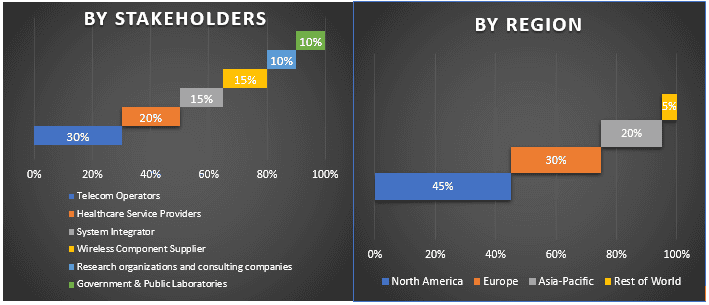- Inicio
- Acerca de nosotros
- Industria
- Servicios
- Leyendo
- Contáctenos
Mercado global de 5G en la atención médica: Análisis actual y pronóstico (2023-2030)
Énfasis en el Componente (Hardware, Servicios y Conectividad); Aplicación (Dispositivos Médicos Conectados, Monitoreo Remoto de Pacientes, AR/VR, Seguimiento de Activos para Dispositivos Médicos y Ambulancia Conectada); Usuarios Finales (Proveedores de Servicios de Salud, Pagadores de Servicios de Salud y Otros Usuarios Finales); Región/País.

El mercado de 5G en la atención médica se valoró en alrededor de USD 34.1 mil millones en 2022 y crecerá a una sólida CAGR de alrededor del 40% durante el período de pronóstico 2023-2030. 5G, la quinta generación de tecnología inalámbrica celular, tiene el potencial de proporcionar una enorme potencia de conexión y velocidades rápidas que pueden ayudar a transformar la prestación de atención médica. 5G puede impactar el Internet de las Cosas Médicas (IoMT). Además, ayudará a habilitar innovaciones médicas mediante la utilización de realidad aumentada, realidad virtual, inteligencia artificial (IA), aprendizaje médico remoto, monitoreo remoto de pacientes y mucho más. Hoy en día, es necesario tener acceso a datos casi en tiempo real, así como tomar decisiones en fracciones de segundo en entornos de atención médica, y 5G brindará beneficios a este sector en el período de pronóstico. La implementación de 5G en la atención médica conducirá a mejores comunicaciones con alta eficiencia, diagnósticos más rápidos a velocidades increíbles y transferencias de archivos, imágenes y otro contenido masivos.
Información presentada en el informe
"Entre los componentes, el segmento de hardware tiene la mayor parte."
Según el componente, el mercado está fragmentado en hardware, servicios y conectividad. El segmento de hardware dominó el mercado en 2022 y se espera que crezca a un ritmo lucrativo debido a la necesidad de una actualización o reemplazo frecuente para hacer un uso óptimo del software más reciente disponible en el mercado. Además, la creciente adopción de nuevas tecnologías en la atención médica y su alta implementación impulsan la demanda de hardware. "Entre las aplicaciones, el segmento de dispositivos médicos conectados tiene la mayor parte."
Según la aplicación, el mercado está fragmentado en dispositivos médicos conectados, monitoreo remoto de pacientes, ar/vr, seguimiento de activos para dispositivos médicos y ambulancia conectada. El segmento de dispositivos médicos conectados dominó el mercado en 2022 debido a la creciente inclinación hacia la atención médica domiciliaria y el crecimiento en el mercado de la telesalud. Según la reconocida empresa multinacional de servicios profesionales con sede en Irlanda, el 65% de los consumidores y el 86% de los médicos están de acuerdo en que los dispositivos portátiles aumentan el compromiso de los pacientes con su salud. Se espera que este compromiso disminuya los costos hospitalarios en un 16% en los próximos cinco años.
"Entre los usuarios finales, el segmento de proveedores de servicios de atención médica tiene la mayor parte."
Según los usuarios finales, el mercado está fragmentado en proveedores de servicios de atención médica, pagadores de atención médica y otros usuarios finales. El segmento de proveedores de servicios de atención médica dominó el mercado en 2022 y se espera que crezca a un ritmo lucrativo durante el período previsto debido a la creciente necesidad de un sistema de atención médica eficiente, el creciente volumen de pacientes y un número creciente de hospitales y centros de atención ambulatoria. Además, el crecimiento de la telesalud, la creciente adopción de dispositivos médicos portátiles habilitados para 5G y la creciente demanda de mejores tecnologías que ayuden en la fácil transferencia de archivos de datos grandes también impulsan el crecimiento del mercado.
"La región de Asia-Pacífico representa uno de los mercados más grandes para el mercado de 5G en la atención médica."
Para una mejor comprensión de la adopción en el mercado de 5G en la atención médica, el mercado se analiza en función de su presencia mundial en países como América del Norte (Estados Unidos, Canadá y el resto de América del Norte), Europa (Alemania, Francia, España, Reino Unido y resto de Europa), Asia-Pacífico (China, Japón, India, Australia y resto de APAC) y el resto del mundo. Se espera que Asia-Pacífico domine el mercado de 5G en la atención médica debido a la presencia de un menor número de proveedores. Además, la adopción significativa de tecnologías avanzadas, el número creciente de dispositivos médicos habilitados para IoT, la mejora continua de la conectividad de la red y las iniciativas gubernamentales para IoT también impulsan el crecimiento del mercado en la región. Algunos de los principales actores que operan en el mercado incluyen AT&T, Verizon, China Mobile Limited, T-Mobile, Ericsson, Telit, Telus, Vodafone, Nokia y Samsung. Varios M&A junto con asociaciones han sido emprendidas por estos jugadores para impulsar su presencia en diferentes regiones.
Cobertura del informe de mercado de 5G en la atención médica

Razones para comprar este informe:
- El estudio incluye el tamaño del mercado y el análisis de pronóstico validado por expertos clave autenticados de la industria
- El informe presenta una revisión rápida del rendimiento general de la industria de un vistazo
- El informe cubre un análisis en profundidad de los pares prominentes de la industria con un enfoque principal en las finanzas comerciales clave, la cartera de productos, las estrategias de expansión y los desarrollos recientes
- Examen detallado de los impulsores, las restricciones, las tendencias clave y las oportunidades que prevalecen en la industria
- El estudio cubre de manera integral el mercado en diferentes segmentos
- Análisis profundo a nivel regional de la industria
Opciones de personalización:
El mercado de 5G en la atención médica se puede personalizar aún más según los requisitos o cualquier otro segmento de mercado. Además de esto, UMI entiende que puede tener sus propias necesidades comerciales, por lo tanto, no dude en conectarse con nosotros para obtener un informe que se adapte completamente a sus necesidades.
Tabla de contenido
Metodología de investigación para el análisis del mercado global de 5G en el sector sanitario (2023-2030)
El análisis del mercado histórico, la estimación del mercado actual y la previsión del mercado futuro del mercado global de 5G en el sector sanitario fueron los tres pasos principales realizados para crear y analizar la adopción de 5G en el sector sanitario para las principales aplicaciones, incluidos los dispositivos médicos conectados, la monitorización remota de pacientes, la RA/RV, el seguimiento de activos para dispositivos médicos y las ambulancias conectadas. Se llevó a cabo una exhaustiva investigación secundaria para recopilar las cifras históricas del mercado y estimar el tamaño actual del mercado. En segundo lugar, para validar estas conclusiones, se tomaron en consideración numerosos hallazgos y supuestos. Además, también se realizaron exhaustivas entrevistas primarias con expertos de la industria en toda la cadena de valor del sector 5G en el sector sanitario. Tras la suposición y la validación de las cifras del mercado a través de entrevistas primarias, empleamos un enfoque de arriba hacia abajo/de abajo hacia arriba para pronosticar el tamaño completo del mercado. Posteriormente, se adoptaron métodos de desglose del mercado y de triangulación de datos para estimar y analizar el tamaño del mercado de los segmentos y subsegmentos a los que pertenece la industria. A continuación, se explica la metodología detallada:
Análisis del tamaño histórico del mercado
Paso 1: Estudio exhaustivo de fuentes secundarias:
Se llevó a cabo un estudio secundario detallado para obtener el tamaño histórico del mercado de 5G en el sector sanitario a través de fuentes internas de la empresa, como informes anuales y estados financieros, presentaciones de rendimiento, comunicados de prensa, etc., y fuentes externas, incluidos revistas, noticias y artículos, publicaciones gubernamentales, publicaciones de la competencia, informes del sector, bases de datos de terceros y otras publicaciones creíbles.
Paso 2: Segmentación del mercado:
Tras obtener el tamaño histórico del mercado de 5G en el sector sanitario, llevamos a cabo un análisis secundario detallado para recopilar información histórica del mercado y cuota para diferentes segmentos para las principales regiones. Los principales segmentos incluidos en el informe son el componente, la aplicación, los usuarios finales y la región/país. Se llevaron a cabo análisis adicionales a nivel de país para evaluar la adopción general de la tecnología 5G en el sector sanitario en las principales regiones.
Paso 3: Análisis de factores:
Después de adquirir el tamaño histórico del mercado de los diferentes segmentos y subsegmentos, llevamos a cabo un análisis de factores detallado para estimar el tamaño actual del mercado de 5G en el sector sanitario. Además, realizamos un análisis de factores utilizando variables dependientes e independientes, como la creciente adopción de IoT en el sector sanitario y el creciente volumen de datos de los pacientes.
Estimación y previsión del tamaño actual del mercado
Tamaño actual del mercado: Basándonos en la información práctica de los 3 pasos anteriores, llegamos al tamaño actual del mercado, los actores clave en el mercado de 5G en el sector sanitario y las cuotas de mercado de los segmentos. Todos los porcentajes de cuota necesarios y los desgloses del mercado se determinaron utilizando el enfoque secundario mencionado anteriormente y se verificaron a través de entrevistas primarias.
Estimación y previsión: Para la estimación y la previsión del mercado, se asignaron ponderaciones a diferentes factores, incluidos los impulsores y las tendencias, las restricciones y las oportunidades disponibles para las partes interesadas. Después de analizar estos factores, se aplicaron las técnicas de previsión pertinentes, es decir, el enfoque de arriba hacia abajo, para llegar a la previsión del mercado para 2027 para diferentes segmentos y subsegmentos en las principales regiones. La metodología de investigación adoptada para estimar el tamaño del mercado abarca:
- El tamaño del mercado de la industria, en términos de valor (US$) y la tasa de adopción de la tecnología 5G en el sector sanitario en los principales mercados a nivel nacional
- Todos los porcentajes de cuota, divisiones y desgloses de los segmentos y subsegmentos del mercado
- Actores clave en el mercado de 5G en el sector sanitario en términos de servicios ofrecidos. Además, las estrategias de crecimiento adoptadas por estos actores para competir en el mercado de rápido crecimiento.
Validación del tamaño y la cuota del mercado
Investigación primaria: Se realizaron entrevistas en profundidad con los líderes de opinión clave (KOL), incluidos los ejecutivos de alto nivel (CXO/VP, jefe de ventas, jefe de marketing, jefe de operaciones y jefe regional, jefe de país, etc.) en las principales regiones. Los resultados de la investigación primaria se resumieron y se realizó un análisis estadístico para probar la hipótesis establecida. Los datos de la investigación primaria se consolidaron con los resultados secundarios, convirtiendo así la información en información práctica.
División de los participantes primarios en diferentes regiones

Ingeniería de mercado
Se empleó la técnica de triangulación de datos para completar la estimación general del mercado y para llegar a cifras estadísticas precisas de cada segmento y subsegmento del mercado de 5G en el sector sanitario. Los datos se dividieron en varios segmentos y subsegmentos después de estudiar varios parámetros y tendencias en las áreas de componente, aplicación, usuarios finales y región/país del mercado de 5G en el sector sanitario.
Objetivo principal del estudio del mercado de 5G en el sector sanitario
En el estudio se señalaron las tendencias actuales y futuras del mercado de 5G en el sector sanitario. Los inversores pueden obtener información estratégica para basar su discreción en las inversiones a partir del análisis cualitativo y cuantitativo realizado en el estudio. Las tendencias actuales y futuras del mercado determinaron el atractivo general del mercado a nivel regional, proporcionando una plataforma para que el participante industrial explote el mercado sin explotar para beneficiarse como una ventaja de ser el primero en actuar. Otros objetivos cuantitativos de los estudios incluyen:
- Analizar el tamaño actual y previsto del mercado de 5G en el sector sanitario en términos de valor (USD). Además, analizar el tamaño actual y previsto del mercado de diferentes segmentos y subsegmentos del sector
- Los segmentos en el estudio incluyen componente, aplicación, usuarios finales y región/país
- Analizar la cadena de valor involucrada con la presencia de varios intermediarios, junto con el análisis de los comportamientos de los clientes y la competencia relacionados con la industria
- Analizar el tamaño actual y previsto del mercado de la categoría 5G en el sector sanitario en todo el mundo. Las principales regiones analizadas en el informe incluyen América del Norte (EE. UU., Canadá, resto de América del Norte), Europa (Alemania, Reino Unido, Francia, resto de Europa), Asia-Pacífico (China, India, Australia, Singapur, resto de Asia-Pacífico) y resto del mundo
- Definir y analizar el panorama competitivo del sector 5G en el sector sanitario y las estrategias de crecimiento adoptadas por los actores del mercado para mantenerse en el mercado de rápido crecimiento
- Análisis regional en profundidad de la industria.
Relacionados Informes
Los clientes que compraron este artículo también compraron










